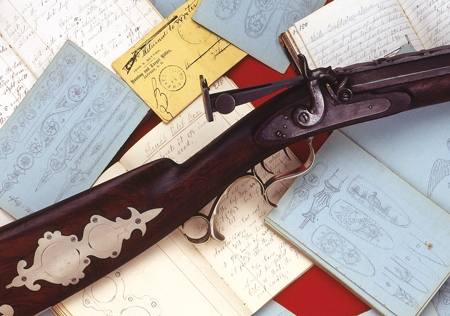The proliferation of superbly assembled and printed, color illustrated auction catalogs, the likes of which have never been previously seen in this field represent a credit to the auction houses that issue them and to the antique arms community in general (and they certainly place generations of gun catalogs that preceded them in their shadow).
This great change of pace was ostensibly brought about by those few auction houses that had the foresight (and good fortune) to acquire from consignees significant outstanding specimens of antique arms and make them available on a reasonably steady basis. With proper promotion and marketing they frequently achieved startling values.
Widely reported in both the general and the antiques press, those exceptional prices were ostensibly the stimulus for owners of similar material to take advantage of what was developing into a really hot market; there was no doubt that it truly was just that. In their aftermath, a veritable flood of great material, the very best of their respective types emerged on the auction scene and so it has remained.
It is important that the collector bears in mind that those record values were achieved by what are considered to have been the very top, the ne plus ultra, of their particular category of firearm and that those very same prices seldom transpose to even slightly lesser rarity, quality or condition levels of identical models. There is little doubt that the notoriety of those auction values has been favorable for the hobby.
They have certainly been responsible for a remarkable turnaround for a number of auction houses. In order that the neophyte collector as well as the veteran gun trader not be carried away by the excitement of those recordbreaking values, it bears repeating that they have seldom had relevance or influenced values on antique arms of the same types if anything less than the very best or the most rare.
A few words about auctions are in order here for the collector … and the dealer. Auctions will continue successful only if they do not revert to their former common practices of taking everyone’s “cats and dogs” with protected prices, while allowing the very owners of those pieces to bid them up during the auction. These abuses were so flagrant that they colored the entire American gun auction market, with but a handful of notable exceptions.
With reputations at stake, it has been observed that many houses have taken great precautions to keep their acts clean. When a legitimate collection has been offered at auction on a no-holds-barred basis, results have often been spectacular. Those results certainly attracted the attention of the collecting world and were equally noted by the auction houses themselves.
Many abuses to which auctions have been, and still are, subject will continue to be the major stumbling block to their success. An uncomfortable feeling exists when auction houses either own all the material themselves or have given healthy loans or advances towards the material they are about to auction. By the very nature of these actions there is an obvious conflict of interest.
This article is an excerpt from Flayderman's Guide to Antique American Firearms. Click here to learn more.








